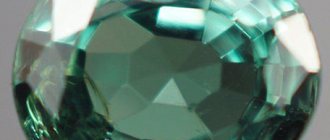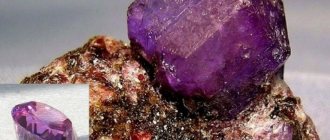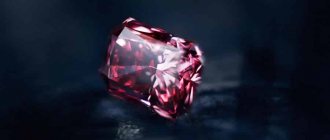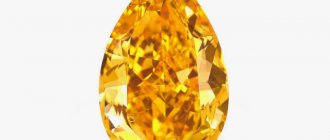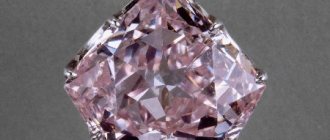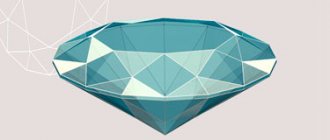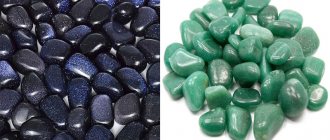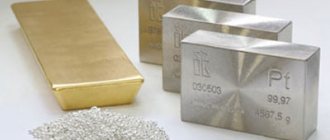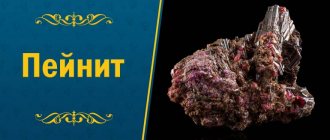Since ancient times, people have used precious minerals to make jewelry. At first, using methods of description and observation, our ancestors tried to classify gems. In the treatise “On Stones,” which Theophrastus wrote in 315 BC, one can find both a systematization of minerals and theories of their origin. Later in the Middle Ages, lapidariums appeared - collections of valuable stones. Lapidariums belong to the genre of descriptive poetry, symbolic literature. Such works not only describe precious or semi-precious stones, but attribute to them symbolic significance and certain magical properties. The first lapidary was written by the king of Arabia, Evax. He called his work “The Lapidarium of King Evax” and presented it as a gift to Emperor Tiberius.
THIS IS INTERESTING . Today, about 2.5 thousand minerals are known, however, only about a hundred of them are considered valuable. Minerals are compounds formed naturally during complex geological transformations. Thus, minerals consist of inorganic substances and have a crystalline structure. In jewelry, in addition to mineral gems, organic materials can also be used.
The scientific branch that studies precious minerals is called gemology (from the Latin word “gemma” means “precious stone”).
Gemology studies the properties of valuable minerals (optical, chemical, physical), their structure, patterns of location of deposits, technical characteristics of stone processing. In 1908, the National Association of Jewelers (NAJ), which is now better known as the Gemological Association of Great Britain, was founded. In any state where jewelry is traded, there are laboratories of gemologists. They can be both public and private. But all gemological laboratories serve one goal - to minimize the risks of buying fakes and low-quality products.
According to their origin, all precious minerals are divided into natural and artificial. Natural ones are formed during natural processes. Synthetic minerals are obtained in laboratory conditions; they are similar to natural ones in their structure and properties. Artificial minerals are inferior in price to natural ones and, as a result, are used as a material for creating various instruments.
Types of Gemstones
The classification of jewelry used by jewelers and gem dealers is extremely difficult to understand and confusing. Today, jewelers do not have a generally accepted division of precious stones. The most common classifications are according to Sobolevsky, Gurich, Kluge, and Kievlenko. Let us dwell on the 1973 classification, which was developed by E.Ya. Kievlenko. She systematized minerals, taking into account the market value of precious stones, their applicability in the production of jewelry and other craft items. Kovalenko E.Ya. divides gems into the following groups: ornamental, jewelry and precious stones, which in turn are divided into orders. The value of a mineral directly depends on the rank of its order - the higher the order, the more expensive the value of the mineral.
Gems
A mineral that is characterized by a high degree of hardness and transparency is considered precious. Such minerals can look like new for a long time and do not lose color (if any). At the head of this group are diamonds. Along with them, blue sapphires, emeralds and rubies are included
in the first order of the first group Diamonds have the highest price among other precious stones. They are obtained during diamond processing. Diamonds are the hardest natural mineral structures.
According to Mohs, they have a strength of 10 maximum points. Diamonds are several dozen times stronger than sapphires, which are rated 9 on the Mohs scale. There is an opinion that the word “diamond” comes from the Greek word “adamas” - “indestructible”; another version says that from the Persian “elma” - “hardest”. Emeralds are green beryls that are exceptionally transparent.
Their color is due to the presence of chromium or vanadium in the composition. Beryls are not very hard, but they are incredibly expensive. Dark green beryls of Colombia are considered high-grade, in the crystals of which vanadium is found. Rubies are distinguished by their rich red color. According to their chemical composition, they, like sapphires, belong to the corundum species. From Latin the word “rubeus” is translated as “red”. The most valuable are red rubies with a slight bias towards a violet hue. This color is also called “pigeon blood” color. It is quite rare to find rubies that contain rutile inclusions. Such stones will have a star-shaped optical effect (asterism effect).
Sapphires are characterized by high transparency. The presence of titanium and iron gives the mineral a blue tint. Depending on the predominance of one or another element, the shades of sapphires range from dark blue, ultramarine, cornflower blue to pale blue.
The second order of the first group includes sapphires of fancy colors, alexandrites, jadeites and black opals.
Alexandrite is chrysoberyl, which has the ability to change color depending on the nature of the lighting. So, in daylight the mineral will have a green color, and in artificial light it acquires a red-violet hue. A similar ability is given to alexandrite by particles of trivalent chromium. Opals by their chemical nature are silica hydrogels, that is, amorphous quartz that contains up to 10% water.
The most valuable is the noble black opal, which is characterized by iridescent tints on its surface. Typically, opals are not cut and are shaped into cabochons. The third order of the first group includes white and fire opals, peridot, spinel, aquamarines, topazes, moonstone and red tourmaline.
Topaz is a fluorine-containing aluminum silicate.
Topazes are a prime example of stones that got their name from the area where they were mined. Few people know that the modern island of St. Johns, located in the Red Sea, was previously called Topazos. These stones usually have pink, yellow or golden hues. There are topazes with pronounced opalescence - topaz “cat's eyes”. Topaz is a mineral with a bright shine that tolerates any treatment, including grinding. According to the Mohs scale, the density of topaz is estimated at eight points out of ten maximum. IV order of gemstones includes blue, green, pink and polychrome tourmaline, hyacinth, beryl, turquoise, amethyst, chrysoprase, garnet, citrine and noble spodumene.
Turquoise is called the “stone of heaven” - this mineral is a hydrated phosphate of copper and aluminum.
Copper ions give turquoise its sky blue color. Iron impurities can give greenish tints to the mineral. Turquoise is a gemologist's nightmare. It is almost impossible to verify its authenticity. Most often, turquoise is imitated with glass and porcelain. Jewelry and ornamental stones are characterized by low hardness, they are opaque, but have a beautiful natural color and often have a characteristic pattern.
The first order of the second group includes rauchtopaz, rock crystal, jadeite, jade, lapis lazuli, malachite and aventurine.
Malachite .
From the Greek “malakos” is translated as “soft”. The name itself indicates that malachite by nature does not require much effort in processing. Malachite can have turquoise, emerald, bluish or black-green colors. In nature, malachite is located in kidney-shaped masses, due to which a concentric pattern is visible on the saw cuts. In the old days, malachite was called “peacock stone.” The second order of jewelry and semi-precious stones includes agate, colored chalcedony, heliotrope, rose quartz, labradorite and other opaque iridescent spars.
Ornamental stones
Ornamental minerals include such minerals as jasper, granite, marble onyx, obsidian, marble and others. They are used as inserts and decoration of stone-cutting products (ashtrays, caskets, etc.).
History and origin
The jewelry name for this gem - aventurine - goes back to the Romance languages, in particular to French, Italian (Tuscan dialect) and their common predecessor - Latin. The Latin root advenio means "to happen" in the sense of "happening unexpectedly."
Ironically, aventurine was originally called a fake of this stone, obtained in a glass-blowing workshop on the island of Murano near Venice. In the 16th century, a glassblower accidentally dropped a handful of copper filings into the glass mass - the result was multi-colored glass, surprisingly similar to the famous ornamental stone.
Brick-colored aventurine
The original European name for aventurine has not been preserved; the gem was “renamed” in honor of a happy occasion. In Russia of the 17th–19th centuries, a stone speckled with a thousand sparkles was called “gold spark” or “spark” . There is also such a name as aventurine quartz.
This is interesting! In Russian, the jewelry name zlatoiskra is consonant with the word “adventure,” that is, “an ill-conceived risky operation, an adventure.” It must be admitted that from an esoteric point of view, aventurine corresponds to its name 100%.
Classification by groups
One of the difficulties in dividing precious stones into groups is their names, many of which were assigned in ancient times. It happened that the name of a mineral came from the place of its extraction or from its color characteristics. For example, golden-colored stones were called topaz, blue minerals were called sapphires. In addition, one mineral could have several fixed names. To resolve this situation, modern mineralogy introduced the concepts of species, groups and varieties of minerals.
Now the type of mineral consists of crystals of the same chemical composition. For example, aluminum oxides are corundum, beryllium and aluminum silicate are beryl. Based on the degree of transparency of the mineral and its color characteristics, one type can be divided into varieties. Species similar in chemical composition form groups of minerals.
Group of pomegranates
The garnet group is a broad type of mineral that belongs to the silicate class.
Typical representatives of the group are grant, rhodolite, grossularide, andralite, pyrope. Garnet is a dark red mineral. This gemstone has many names. In particular, Pliny the Elder called a mineral similar to flickering coals a carbuncle (from “carbon” - “coal”). Garnets, along with other red gems, were sometimes called anfrax. In Ancient Rus', pomegranates were known as chervetsy, becheta, and venice.
Rhodolite is translated from Greek as “pink stone”. Rhodolites are a type of pyrope, which is a silicate from the garnet group. Large rhodoliths are relatively expensive.
Quartz group
Quartz is silica dioxide.
This is the most common mineral. Regular glass or translucent grains of sand on the beach are great examples of quartz. Quartz is a large group of minerals. In particular, rock crystal is nothing more than its transparent variety. Amethyst is a variety of quartz that is characterized by a violet color ranging from dark purple to pinkish.
Amethysts are mined in Brazil, Uruguay and Sri Lanka. Amethysts are relatively inexpensive; this fact is primarily explained by the presence of artificial amethysts on the market, which are extremely difficult to distinguish from natural ones. Jasper is a whole class of minerals that consist of siliceous rocks with various impurities: chalcedony, iron, aluminum; constituting up to 20% of the crystal. The Greek word “iaspis” is translated as “variegated,” which indicates the color diversity of this mineral.
Group of organic materials
Organic materials are formed by a living being and, to varying degrees, consist of organic and inorganic parts. This group of materials includes coral, pearls, amber and jet.
Pearls do not require additional processing. This material is formed in the body of mollusks inside the oyster bag. A mollusk, when a particle of a foreign substance enters its body, envelops it in layers of calcium carbonate, held together by organic matter. The more layers, the larger the pearl. The growth of pearl layers is a very slow process. Natural pearls are found not only in white colors. It can be yellow, blue, red and even black.
Feldspar group
Feldspars are silicon silicates that make up up to 50% of the mass of the earth's crust.
When feldspars break down, sedimentary rocks and clay are formed. Feldspars can often be found combined with quartz crystals. Feldspars include albite, labradorite, anorthite and other minerals. Labradorite is an opaque dark blue feldspar. If you polish this mineral well, you can achieve an interesting optical effect when golden, blue, indigo and green “lights” shimmer across the surface of the mineral. In Finland, labradors are mined, which are cast in all the colors of the rainbow. They are called spectrolites.
Group of Jades
Jades are a group of translucent minerals of pyroxene and amphibole composition.
Jades include: vesuvianite, grossularite, calcite, obsidian and chrysoprase. Jadeite is the same as jade. Jadeite is a type of jade, which is distinguished by impurities of sodium compounds.
The mineral is quite durable and well valued. Hard jadeite is highly polished, so the stone can be given shine. Chromium and iron give jadeite its green color. Particularly prized is the translucent “noble” or “imperial jade,” which is mined in Burma. Obsidians are volcanic glass. In nature, you can find obsidians in black, gray, yellow, red and brown colors. Gray-white obsidians are called snow obsidians. Pendants, pendants and rosaries are often made from this stone.
Mining locations
Aventurine is a fairly common gem found in nature. In Russia, its deposits are located in the Urals, in the town of Taganay (by the way, hence the local name - “taganaite”). Other mining areas are scattered around the world: in Europe they are located in Austria, Spain and Norway, in Asia - in China and India, in the Americas, production is carried out in Chile, Brazil and the USA. It is also found in Australia.
It should be noted that gold sparks of different colors are mined in different deposits . In Asia, green is most common, in the US - golden, and so on.
Colors and varieties
Aventurine has surprisingly many faces - exactly like His Majesty's case. Its main colors are green, honey, gold, cherry, but the color of the spark is not uniform: the main color is “accompanied” by tints, stripes, dots and inclusions of other colors - white, gray, golden, brown, purple. In fact, the stone is painted in very small speckles, and only its background color is clearly identified.
The least common varieties are pink, blue and black. The last two are most highly valued, as they are very beautiful. Alas, for the same reason, blue and black taganaites are the main objects of counterfeiting.
Blue aventurine
Black aventurine
The stone is not smooth to the touch, but fine-grained. The grain size varies among different subspecies, since it depends on the conditions in which the stone was formed. The main types of defects are large pores and shagreen.
The most common types:
- green with dark and light splashes, the so-called “Indian jade”;
- golden-cherry - burgundy stone with golden inclusions, very beautiful;
- plain cherry brown;
- yellow honey-colored, distinguished by a characteristic “spark”;
- uniform pinkish-white;
- white striped;
- cherry white striped.
Blue and blue-black gems are much less common. They can have golden, grayish, white and purple inclusions. Golden cherry has the smallest grain size and is the smoothest to the touch. This is exactly what the accidentally invented “Murano glass” with the addition of copper filings turned out to be similar to . Now it is known as aventurine.
Bracelet made of golden cherry aventurine
Types of cuts
Its brilliance and the play of light on the surface largely depend on the cut of a gemstone. Cutting refers to the technique of processing a mineral, upon completion of which a certain shape of a stone is formed with a certain number of faces, their location, proportions relative to each other and characteristic outlines. Let's look at the most commonly used types of cuts:
Round cut
Number of faces: 17, 33, 57
The round cut is something of a classic. The history of this cut goes back more than a hundred years. It is perfect for diamonds, as it collects and enhances the shine of the stone. In addition, the round cut protects the gemstone from chips and other damage. The lighter the stone (the smaller the carat), the fewer facets the jeweler will carve. Fly in the ointment - with this cut, up to 50% of the original weight of the gem is lost.
Oval cut
Number of faces: 57
This option for cutting stones has been known since the 60s of the 20th century. The “oval” cut has a more elongated shape than the round cut; and allows the stone to play with iridescence in the light. Gems cut into oval shapes are often used in rings to visually lengthen the fingers.
Marquise cut
Number of faces: 55
The Marquise cut is similar to a boat and is an oblong oval with pointed corners at the edges. As with the oval cut, the marquise cut on the ring elongates the fingers. However, be aware that the sharp wedges at the ends of the stone will become vulnerable and brittle.
Drop cut (Pear)
Number of faces: 55-56
The “Drop” combines the features of the “Marquise” and “Oval” cuts - on one side the gem will have a rounded end; and on the other hand, it’s spicy. The sharp end acts as a vulnerable point of the gemstone, prone to cracks. Therefore, experienced jewelers try to protect it with a frame. A teardrop-shaped cut of a gem in a necklace or necklace will advantageously lengthen the neck.
Princess cut
Number of edges: 49, 65,68
The “Princess” has a square or more often rectangular shape. Like the round cut, the Princess cut maximizes the brilliance and brilliance of the gem. In addition, when choosing this cut, the nugget will lose less of its original weight. This cut is often used for engagement ring diamonds. Like any other sharp corners, the tops of the “Princess” must be reliably protected by the frame.
Cabochon
Cabochoning is a method of processing stone to give it a rounded, convex shape (sometimes flat on one side). Most often, this cutting method is used when processing impenetrable or low-permeability stones; as well as stones that have any optical effects (for example, asterism or opalescence).
Zodiac compatibility
In astrology, aventurine is optimally suited to the signs of the Earth elements: Virgo, Taurus and Capricorn. This is due to the initial “down to earth” nature of the representatives of these signs, the lack of ability to take risks and win with charm and luck. On the contrary, golden sparks are strictly contraindicated for the signs of Fire - Leo, Sagittarius and Aries: there is already too much flame in their lives.
| Zodiac sign | Compatibility |
| Aries | — |
| Taurus | +++ |
| Twins | + |
| Cancer | + |
| a lion | — |
| Virgo | +++ |
| Scales | + |
| Scorpion | + |
| Sagittarius | — |
| Capricorn | + |
| Aquarius | + |
| Fish | + |
(“+++” – fits perfectly, “+” – can be worn, “-” – is strictly contraindicated)
Classification by quality
This list of qualities is responsible for the visual beauty and aesthetics of the stone.
Color
It is impossible to determine the type of mineral solely by color. Even minerals of the same type vary significantly in their shades depending on the presence of certain impurities. The average buyer can easily confuse, for example, topaz and sapphire. And only an experienced homologist, using special crystallographic methods, will be able to determine whether a mineral belongs to a certain species. By color there are white, yellow, purple, red, green, black, pink and blue gems.
Transparency
Transparency is a very important property of a gemstone, on which its price largely depends.
Gemologists understand transparency as the ability of a mineral to transmit light through itself. The transmission of light is influenced by the structure of the crystal; as well as the presence in the structure of the mineral of defects or inclusions that distort the flow of light. The degree of light transmission of a certain mineral is determined by a spectrophotometer. According to the degree of transparency, minerals are divided into:
- absolutely transparent - lightly colored or colorless gems, through which objects are clearly seen, without any changes;
- half transparent - colored and colorless stones, through which you can observe objects distorted or blurred;
- minerals that transmit light in thin layers. Light can usually only penetrate the surface layer, but nothing can be seen through the crystal as a whole;
- opaque - do not allow light to pass through.
Shine
Luster refers to the ability of a mineral to refract or reflect light. There are the following types of shine in precious stones:
- Diamond - the reflection of light from the surface is quite strong. Diamonds and zircon, for example, have a diamond-like luster.
- Glassy – reflects light like glass. As an example, we can name, for example, corundum.
- Waxy - slight gloss on a matte surface. Turquoise and jasper have a waxy luster.
- Metallic – strong shine on the surface of opaque minerals. For example, hematite, pyrite.
- Resinous - amber.
- Mother-of-pearl or multi-colored shimmer - pearls, opal.
Hardness
The degree of hardness of gems is determined by the Mohs scale from one to ten maximum points.
As standards, each point corresponds to a specific mineral. The undisputed leaders of the Mohs scale are diamonds - 10, followed by corundum - 9. The hardness of topaz is estimated at 8 points. Topazes are followed in descending order by quartz - 7 points, orthoclase (opal) - 6, apatite - 5, fluorite - 4, calcite - 3, gypsum - 2 and talc - 1. The arrangement of other minerals is determined by their ability to scratch each other's surface. If the material under study scratches the standard, then its hardness is higher than the hardness of the given standard; if not, lower. The harder the mineral, the denser it is, the longer it retains its cut, does not wear off and looks new.
Color meaning
Black stones can be transparent or opaque, shiny or matte, but their color symbolizes the same concepts. It has always been popular, hence many interpretations:
- In ancient times, it was called the messenger of troubles, and only widows and sorcerers could wear jewelry. The latter used crystals in ritual ceremonies, considering them elements of magic and mystery.
- Symbolizes restraint and secrecy.
- For people who teach others, dark gems are favorable and accompany success.
- Demonstrates a person's reliability in relationships with his companion.
- The nature of black is the negation of other colors that it absorbs. It is used to draw attention not to color, but to form and content.
- In clothing it means conservatism and adherence to traditions.
Application
This is a popular ornamental stone that is used in souvenirs and jewelry . A silver ring with aventurine is suitable for both men and women (signet rings with blue or black taganaite are recommended for men). In addition, beads, earrings, pendants, and, less commonly, tiaras and other jewelry are produced with it. A simple pendant with this stone will also look good.
Pendant with green aventurine
Aventurine is often used for inlaying luxury items - boxes and chests; various figures and figurines are cut out of it. The standard cut shape is cabochon (flat base and hemispherical top), table cut is used for rings.
This stone is sometimes not cut at all, but only polished. It is quite popular in its “unprocessed”, raw form. For the needs of those involved in home crafts, aventurine is often produced in the form of spherical or toroidal beads, hearts, fangs, drops, pyramids and similar shapes.
dug
By its nature, it is in many ways reminiscent of amber, because it is a hardened tree resin, but the resin of amber comes from conifers, and not from leguminous plants. In addition, amber has existed for millions of years, and copal hardly exceeds the “age” of only 1000.
Externally, copal can be impossible to distinguish from amber, especially from some of its varieties. Autoclaving using various chemicals increases the density and hardness of the legume resin. One of the most common ways to attract buyers is the “art” of introducing some insect into a liquid resinous drop, and then saying that this is the work of nature itself.
Cowrie resin
It is distinguished by trees with the same name, which are a type of conifer. They secrete resin abundantly if the root system is severely damaged. Sometimes the resin weight can be half a ton or even more. However, its chemical composition resembles amber only approximately. The same applies to the physical characteristics of cowrie resin. These trees are also copal trees. Their resin is used in the production of high-quality varnishes, and only some “manufacturers” are engaged in counterfeiting it as amber.
In Auckland, New Zealand, there is a museum in which a huge room is dedicated to kauri trees. As ordinary people say, the resin of this tree is completely impossible to distinguish from amber in appearance.
How to spot a fake
Unfortunately, fake aventurines are far from uncommon on the market. Most often, “aventurine glass” containing additives is passed off as a real stone: shavings of non-ferrous metals, primarily copper.
It’s easy to distinguish imitation:
- Firstly, it is bright and contrasting. A very rich color, especially red-brown, black or blue with bright, clearly visible sparkles, is a sure sign of a fake glass.
- Secondly, the natural mineral has a greasy, rather than glassy, sheen and exhibits an iridescent effect. Synthetic is devoid of these effects.
- Thirdly, in natural stone the arrangement of inclusions of a different color is chaotic - somewhere there are fewer of them, somewhere there are more. In imitation they are ordered.
- Fourthly, genuine aventurine is harder than glass. It scratches glass like a ruby or diamond, but it itself, on the contrary, is difficult to scratch.
- And fifthly, a natural gem, even polished, is rough to the touch. It has a porous structure and feels warm in the hand. It may have flaws and defects, but fakes are always perfect.
True aventurine
According to statistics, the most frequently counterfeited stones are blue, cherry, brown and black. Less commonly - green, white and pink.
Bakelite
This artificial stone was invented by the American chemist Leo Backland: he treated phenol with formaldehyde, and the world's first synthetic plastic was obtained. Backland himself did this experiment simply out of curiosity and not at all so that the material he created would be used to make amber fakes. However, fate decreed otherwise.
Initially, bakelite plastic became widespread in the manufacture of spare parts for various devices, as well as their housings - in the field of mechanical engineering and electrical engineering. Bakelite was successfully used to produce brake pads, adhesives and construction varnish.
In Germany, bakelite, along with polyburnum, found its use in the manufacture of jewelry “like amber.” The invention of Bakelite happened just at the time when the First World War ended. People did not have the financial ability to buy expensive jewelry made from natural stones. That is why the synthesis of “analogs” from plastic has become so widespread.
Phenol-formaldehyde resin itself has no color, but if you introduce some impurities into it and apply simple processing technologies to it, it acquires a beautiful, amber-yellow color. Thus, the markets of all European countries were soon filled with bakelite products “under amber”. By the way, a famous one has adopted this technology. Now the company actively uses bakelite in the manufacture of its famous pens.
Faturan
This material was invented a long time ago and deserves some respect. It was created in the 17th century, when Eastern craftsmen processed amber dust and shavings, mixed them with resins of various origins, and then heated and pressed them. This is how faturan turned out. Products made from faturan are distinguished by their amazing beauty: their color is honey-red with a wonderful matte tint. Unfortunately, the production technology was lost, and it is no longer possible to restore the original methods of producing faturan.
But when Bakelite became a powerful commercial success in Europe, a certain Dr. Thrawn from Hamburg modified it in ingenious ways, giving it a resemblance to faturan. Thrawn simply tinted the stone, and the fraudulent plan was a success. Thrawn's company was actively engaged in the manufacture of faturan counterfeits until the early forties of the last century and supplied them to the East. Modern “craftsmen” are still engaged in this fraud, counterfeiting both amber and faturan by mixing who knows what synthetic materials.
Bernit
Bernite may contain a small percentage of amber substance - about 5%. Large jewelry companies have long abandoned the imitation of amber using it. The artificial bernite stone itself is often painted in different colors and sold as an independent product, which is in good demand. However, those polyester compounds that are present in bernite can “pass” well as transparent honey amber. Defects are still artificially created in bernite, making it difficult to distinguish it from amber with the naked eye.
Initially, the production of bernites looked like this: amber powder was mixed (sintered) with polyester resin. Under conditions of the process occurring in an oxygen environment, the color of the stone turned out to be yellowish with a red tint, and if it was heated in a nitrogen environment, it turned green. Today, the range of bernite products is very wide, with virtually the entire color range available. It may also happen that prices for amber will rise significantly, which means that the number of fakes made of burnite will also increase.
Inclusions
Inclusions are the remains of once living organisms, “sealed” by nature in a petrified drop of amber resin. Sometimes there are whole insects that can be clearly seen inside the jewelry. Fraudsters skillfully take advantage of the fact that buyers like the exotic look of inclusions. They place flies, bugs and other insects in gradually hardening synthetic materials.
It is very easy to distinguish fake inclusions from natural ones: insects that were captured by resin many millions of years ago have long since lost their flesh and acquired a translucent color. All that remains from them is a chitinous cover, or an imprint of the exact shape of a particular creature.
As for fake inclusions, they represent insects as if they had just gotten inside the product. By the way, it is synthetic polymer fakes of amber that sometimes serve as an excellent preservative for blowflies, and if it was placed inside synthetics 200 or 300 years ago, centuries later it will look as green as before.
Of course, counterfeits can be of very high quality, and buyers are still falling for them, while deceivers and scammers continue to expand their arsenal of means to engage in criminal deception. Various types of resins of other origins and synthetic materials, unfortunately, are increasingly being passed off as amber, and sometimes only very experienced specialists can recognize their true “nature”.
Read about how to distinguish real amber from a fake →
Agate
All agates, from the point of view of a geologist, are chalcedony, a special type of quartz. Agates are famous for the richness of their colors and patterns. It is difficult to find another stone in which nature would demonstrate such a richness of color, lines and shapes. In agates, the riot of natural imagination is simply limitless!
Blue agates are called sapphires. By the way, many reference books classify them as precious stones. But another type of agate - sardonyx - has characteristic whitish stripes in its design.
